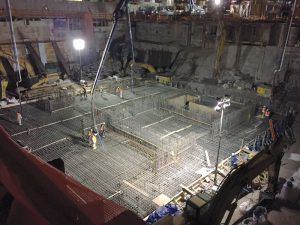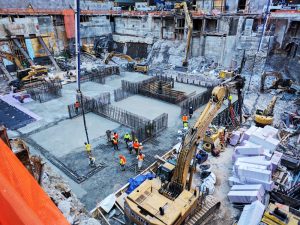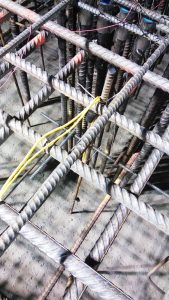There are many issues that arise when one places mass concrete, specifically as it relates to reinforced concrete elements in buildings. These elements, which most typically include reinforced mat foundations, pile caps, footings, piers, and transfer elements, differ from other reinforced structures such as dams and retaining walls due to high stresses, quantities of steel reinforcement, and the use of high strength concrete. Mass concrete element placement in buildings, therefore, presents unique challenges.
Mass Concrete: When It Applies
The definition of mass concrete per the American Concrete Institute (ACI) is “any volume of concrete with dimensions large enough to require that measures be taken to cope with generation of heat from hydration of the cement and attendant volume change to minimize cracking” (ACI 116R and ACI 301). Although no specific thickness is given, a member thickness of three feet is often used as the threshold dimension for when mass concreting procedures are to be set in motion. Note that there may be circumstances where members with a thickness less than three feet will call for mass concreting procedures. The final determination as to whether mass concreting procedures should be followed is at the discretion of the Structural Engineer of Record (SER).
ACI 207
The ACI Committee 207 provides several reports for guidance in the use of mass concrete. ACI 207.1, Guide to Mass Concrete, is the primary resource for guidance in the use of mass concrete for structural building elements. Most of the data and concerns related to the use of mass concrete were formulated from lessons learned during the United States golden era of dam construction. It was during the construction of these massive structures more than one hundred years ago that issues related to the placement of mass concrete began to emerge. During dam construction, the strengths of concrete required were low (typically under 5,000 psi) compared to the requirements for strength of current building elements, where concrete strengths can exceed 10,000 psi. Although many of the recommendations from ACI 207 may be useful for these types of structures, other recommendations from ACI 207 may not be practical for building elements.
Goals of Mass Concreting
The ACI definition of mass concrete names heat generated within the member due to the heat of hydration as a core concern. It is this heat, if not controlled, that can have detrimental effects on the concrete element. These could include cracking, delayed ettringite formation (DEF), and other issues. Another core concern with mass concreting is the potential formation of cold joints in the element. This is a problem more common to building structures as the use of higher strength concretes will rapidly accelerate the setting time of the concrete.
Temperatures
ACI 301 provides two recommended temperature limits:
a) The maximum concrete temperature shall not exceed 160 degrees Fahrenheit during curing, and
b) The maximum temperature differential between the center and surface of placement shall not exceed 35 degrees Fahrenheit.
These limits are in place to avoid delayed ettringite formation (DEF) which can cause cracking and reduce concrete strength. Although these temperature limits may not seem significant, they can often be difficult to achieve, especially the restriction on the temperature differential.
Beginning concrete placement with a lower initial concrete temperature is recommended to keep the concrete from reaching upper-temperature limits. Typical methods to keep concrete temperatures low include the introduction of crushed ice to the mix in lieu of some of the mixing water and the use of precooled aggregate. For times when the ambient temperatures are high, it may be necessary to post-cool the concrete via embedded cooling coils. Other than when insulation is used, the use of curing water on the slab is essential to prevent water loss and assist in the curing operation.
In a normal concrete element, a temperature gradient is created between the interior, where the heat of hydration is trapped, and the exterior surface of the concrete that is transferring heat to the atmosphere. In colder weather, insulation is added to the top of the slab to maintain the thermal temperature gradient and prevent the top from cooling more rapidly than the core. Trying to maintain this same 35-degree differential when the interior of the concrete is “insulated” with several feet of concrete above and below it, zones that are also generating heat, is difficult when the exterior of the concrete is exposed to colder atmospheric temperatures, even with the use of insulating blankets. Note that the 35-degree limit is a general recommendation to prevent deterioration of the concrete due to the separation of concrete layers, but it is often at the discretion of the Engineer of Record whether higher temperature differentials may be tolerated.
Mix Designs
Many recommended changes to the concrete mix for mass concreting reduce or slow the heat of hydration to limit temperature change and thereby lower the amount of crack formation. It is critical to reduce the quantity of cement in the mix. The replacement of cement with slag and fly ash (and now ground glass pozzolans) can help maintain required strengths. The use of larger aggregates can also help; however, this can often be difficult as the congestion of steel reinforcement and the method of concrete placement may restrict the aggregate sizes. Admixtures used for air entrainment, water reduction, set time, and shrinkage reduction, strength, and durability can be adjusted to slow or reduce the heat of hydration.
Monitoring Concrete Temperatures
The monitoring of concrete temperatures in mass concreting is commonly achieved through the use of thermocouples. These sensors are buried within the structural element prior to the concrete placement operation. Often, the SER generates a three dimensional grid that allows the temperature gradient to be plotted throughout the cross-sectional area of the element. The sensors report the temperature within the element and enable the engineer to verify that the temperatures have remained within the desired range from the initial concrete placement until final concrete curing operations are complete. When temperatures approach the limits of the desired range, changes can be made to the curing procedures, such as the addition or removal of insulating layers to balance the temperatures.
Cold Joints
A cold joint forms when concrete already placed within the element begins to set even as subsequent layers of concrete are still being placed on top of it. The formation of a cold joint negates the monolithic properties that are always desired and, unlike a planned and formed construction joint, it is typically haphazard in its locations and is horizontal or on a slope. The failure plane created within the structural element is often hard to document, as it usually happens in the middle of the concrete placement when operations are the most hectic.
Avoiding cold joints takes prior planning. During a pre-placement meeting before the start of mass concreting operations, it is important to plan and discuss the order of concrete placement and the number of placement points. The order in which the concrete is intended to be placed should be strategic to avoid leaving specific areas for extended periods where concrete can start to set prior to additional concrete being placed next to it. Maximizing the number of points of placement keeps concrete flowing as much as possible. The pre-placement meeting may reveal that, due to site restrictions, the formation of a cold joint in an element is highly probable. The SER may need to consider the addition of strategically placed construction joints within the structural element to minimize the risk of a cold joint forming, and provide for the reliable transfer of forces.
The use of a retarding admixture or a set delaying admixture is important to prolong the workability period of concrete and can help control temperatures. A typical procedure is to start the early concrete trucks with the maximum recommended quantity of admixture and then slowly taper off the admixture during concrete placement. Tapering the admixture during placement helps keep the concrete workable and also supports constructability for the contractor. The added fluidity of the concrete late in the placement increases the pressure head on the formwork system. Additionally, for most elements, laborers must remain on site until finishing and curing procedures are completed. If the retarding admixture is used in its full dosage until the end of the placement, the staff needs to wait on site for many additional hours beyond the pour until they can walk on the concrete and begin finishing/curing. Tapering the quantity of the admixture allows for more efficient staffing.
A licensed structural engineer or an ACI certified technician observing the placement is recommended to help prevent the formation of cold joints. The engineer, in concert with the contractor, can use observations to make strategic real-time changes to the pour sequencing. The contractor can come back with a small amount of concrete to refresh an area that is starting to set and potentially form a cold joint. The pour can then continue.
Unfortunately, even with the best planning, things can go wrong – a pump breaks, the concrete delivery is delayed, and so forth. It is critical that someone on site, typically the inspector or engineer, record and document the location of any cold joints that form. This allows the Engineer of Record to more accurately evaluate the impact to the structure and provide the most efficient remediation, if one is required.
Conclusion
This article describes general approaches to address some of the mass concreting concerns that are particularly relevant to building structural systems. Several ACI publications are available for more information.▪
Review the following publications for additional information, considerations, and approaches for mass concreting.
ACI 207.1 – Guide to Mass Concreting
ACI 207.2 – Report on Thermal and Volume Change Effect on Cracking of Mass Concrete
ACI 207.4 – Cooling and Insulating Systems for Mass Concrete



